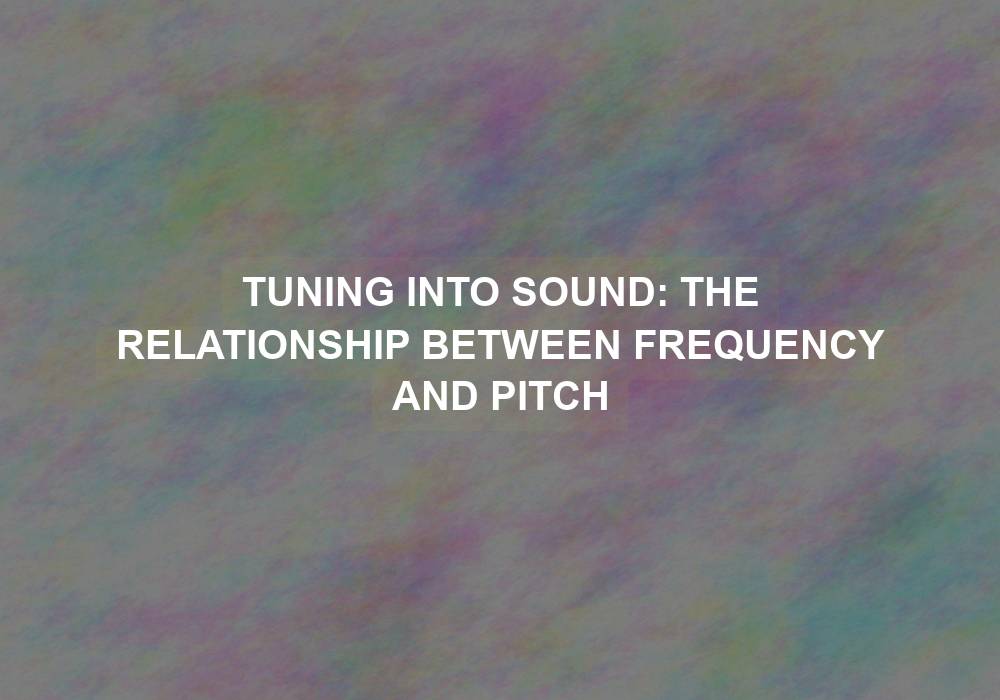Sound is a fascinating phenomenon that surrounds us in our everyday lives. It encompasses everything from the cheerful chirping of birds in the morning to the soul-stirring melodies that uplift our spirits. But have you ever wondered how we perceive the pitch of different sounds and what determines their frequency? In this article, we will delve into the intriguing concepts behind frequency and pitch, exploring their relationship and shedding light on the captivating physics of sound.
Understanding Frequency and Pitch
Frequency is a fundamental characteristic of sound that refers to the number of cycles a sound wave completes in one second. It is measured in Hertz (Hz) and directly influences the highness or lowness of a sound. On the other hand, pitch is the subjective perception of how high or low a sound is. While frequency and pitch are closely related, pitch involves our auditory interpretation of the sound.
The Physics of Sound
To grasp the relationship between frequency and pitch, we must first delve into the physics behind sound. Sound is created by vibrations, which are disturbances that travel through a medium, typically air. When an object vibrates, it causes the air particles around it to vibrate as well, resulting in a series of compressions and rarefactions. These compressions and rarefactions collectively form what we perceive as sound waves.
The frequency of a sound wave is determined by the rate at which the source of the sound vibrates. For instance, if a tuning fork vibrates at a frequency of 440 Hz, it will produce an audible tone with the same frequency. This means that the tuning fork completes 440 cycles of vibration in one second, generating a specific pitch.
How Frequency Affects Pitch Perception
Our perception of pitch is closely linked to the frequency of a sound wave. Generally, higher frequencies are associated with higher pitches, while lower frequencies are associated with lower pitches. However, this relationship is not purely linear.
The human auditory system is incredibly complex and enables us to perceive a wide range of pitches. It comprises various structures, including the ear canal, eardrum, and cochlea. The cochlea, in particular, plays a vital role in pitch perception.
Within the cochlea, there are tiny hair cells responsible for converting sound vibrations into electrical signals that can be interpreted by the brain. These hair cells are tuned to respond to specific frequencies. When a sound wave enters the ear, the hair cells that correspond to its frequency will vibrate, sending signals to the brain, which then interprets the pitch.
Interestingly, factors such as harmonics and overtones can affect our perception of pitch. Harmonics are multiples of the fundamental frequency, which is the lowest frequency component of a complex sound. Overtones, on the other hand, are higher-frequency components that accompany the fundamental frequency. The presence and relationship between harmonics and overtones can influence how we perceive the pitch of a sound.
The Role of Musical Instruments in Frequency and Pitch
Musical instruments are specifically designed to produce distinct frequencies and pitches. They achieve this through various means, such as altering the length, thickness, or tension of strings or the length of the air column in wind instruments.
For instance, on a guitar, shorter and thinner strings vibrate at higher frequencies, producing higher-pitched notes. Conversely, longer and thicker strings vibrate at lower frequencies, resulting in lower-pitched notes.
Similarly, in wind instruments like flutes or trumpets, the length of the air column determines the pitch. Musicians can change the effective length of the air column by altering fingerings or valve combinations, thereby producing different pitches.
Practical Applications of Frequency and Pitch
Understanding the relationship between frequency and pitch finds practical applications in various fields. Here are a few examples:
-
Music Production: Music producers and audio engineers manipulate frequency and pitch to create harmonious compositions. They make use of equalizers, pitch correction software, and other tools to fine-tune the frequencies of individual instruments or vocals, resulting in a balanced and pleasing sound.
-
Speech Therapy: Speech therapists work with individuals who have difficulties in speech production. They analyze the frequency and pitch patterns in the client’s speech and provide targeted exercises to improve their communication skills. By focusing on specific frequency ranges and pitch variations, speech therapists can help individuals enhance their speech clarity and expression.
-
Hearing Aid Technology: Hearing aids are designed to amplify specific frequencies based on an individual’s hearing loss. By selectively amplifying certain frequencies, hearing aids can enhance a person’s ability to perceive and understand speech, thereby improving their overall auditory experience.
Conclusion
The relationship between frequency and pitch is a captivating aspect of the world of sound. While frequency determines the objective characteristics of a sound wave, pitch is the subjective perception of its highness or lowness. Our complex auditory system, combined with the craftsmanship of musical instruments and various applications in fields like music production, speech therapy, and hearing aid technology, harnesses this relationship to enhance our understanding and enjoyment of sound. So, the next time you tune into your favorite song or engage in a conversation, take a moment to appreciate the intricate connection between frequency and pitch that shapes our sonic experiences.
